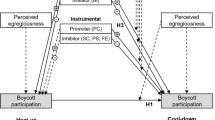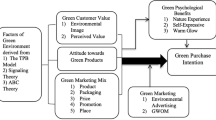Abstract
In the western world, and in the United States in particular, there has been an abundance of food, materials and fuel over the past several decades. However, many futurists suggest this condition will soon change and a wide range of scarcities will result. Conditions in underdeveloped countries suggest one probable reaction to shortages in hoarding. In light of the predicted shortages this paper (1) develops definition and conceptualization of what constitutes hoarding, and (2) examines the influence hoarding activities have on channel decisions. An overriding purpose of the paper is to generate interest and research into the topic before conditions necessitate that concern.
Similar content being viewed by others
References
Advertising Age, 1974, “Panic Mongering in Marketing,” (February), 16.
Alderson, Wroe and Martin, Miles W., 1965. “Toward a Formal Theory of Transactions and Transvections.”Journal of Marketing Research, (May), 117–127.
Becker, B.W., Brown, D.J., and Schary, P.B. 1976, “Behavior of Car Owners During Gasoline Shortages.”Traffic Quarterly, Vol. 30, 469–483.
Blundell, J.E., 1973, “Effectiveness of Lateral Hypothalamic Stimulation, Arousal and Food Deprivation in the Initiation of Hoarding Behavior in Naive Rats.”Physiology and Behavior, Vol. 10, 763–767.
Bucklin, Louis P. 1965, “Postponement, Speculation and the Structure of Distribution Chanels,”Journal of Marketing Research, (February), 26–31.
Cravens, David W., 1974, “Marketing Management in an Era of Shortages,”Business Horizons, (February), 74–78.
Curtain, Richard T. 1975, “Consumer Adaption to Energy Shortages,” Paper presented at 83rd Convention of American Psychological Association Div. 23, (August), Chicago, Ill.
Free, J.B., 1975. “Hoarding by Honeybees,”Animal Behavior, 20, 327–334.
Gelb, Betsy, D. 1975, “Consumer Hedgehogs: Hoarding as a Response to Shortages and Inflation,”1975 Combined Proceedings American Marketing Association, Series 37, Edited by Edward M. Mazze, 261–274.
Graham, James B. and Robinson, William, 1981, “Buyer Expectations and Responses to Shortages,” The Changing Marketing Environment: New Theories and Applications,1981 Educator's Conference Proceedings, Kenneth Bernhardt et al.
Hallett, Graham, 1979, “The Commodity See-Saw,”Management Today, (August), 5–8.
Johansson, J.K., 1978, “Unobserved Variables, Stochastic Parameter Regression and Demand Analysis: The Case of Gasoline Hoarding,”Research Frontiers in Marketing, Dialogues and Directions, 1978 Educator's Proceedings, Series #43, AMA, Subhash C.
Johnson, Manuel H., 1980, “Natural Resource Scarcity: Empirical Evidence and Public Policy,”Journal of Environmental Economics and Management, (September), 256–271.
Kelley, Eugene J. and Scheewe, L. Rusty, 1975, “Buyer Behavior in a Stagflation/Shortages Economy,”Journal of Marketing, Vol. 39, No. 2, (April), 44–50.
Kotler, Philip, 1973, “Marketing During Periods of Shortage,”Journal of Marketing, 38, (July), 20–29.
Levy, Sidney J. and Kotler, Philip, 1971, “Demarketing, Yes, Demarketing,”Harvard Business Review, 49, (November–December), 74–80.
Lore, Richard and Moyer, Ronald, 1973, “Early Feeding and Food Hoarding in Rats,”Development Psychology, Vol. 8, #2, 313.
Main, Jeremy, 1974, “When Shops Have Plenty of Nothing,”Money, (July), 29–30.
Malcolm, Andrew H., 1974, “The Shortage of Bathroom Tissue, A Classic Study of Rumor,”New York Times, (February 3), 29–48.
Nyby, John, 1973, “An Influence of Hormones on Hoarding Behavior in the Mongolian Girbil,”Academic Press, 283–288.
Pike, C.R., 1981, “Fuel Realities and Canada's Railways,”Logistics and Transportation Review, (Canada).
Rigby, Paul H., 1965,Conceptual Foundations of Business Research, New York, John Wiley and Sons, 129–138.
Stiff, Ronald, Johnson, Keith and Tourk, Chairy Ahmed, 1974, “Scarcity and Hoarding: Economic and Social Explanations and Marketing Implications”Advances in Consumer Research, Vol. 2, Mary Jane Schlinger, editor, 203–215.
Verhallen, T.M., 1982, “Scarcity and Consumer Choice Behavior,”Journal of Economic Psychology, Vol. 2, 299–322.
Author information
Authors and Affiliations
Rights and permissions
About this article
Cite this article
McKinnon, G., Smith, M.E. & Keith Hunt, H. Hoarding behavior among consumers: Conceptualization and marketing implications. JAMS 13, 340–351 (1985). https://doi.org/10.1007/BF02729724
Issue Date:
DOI: https://doi.org/10.1007/BF02729724




